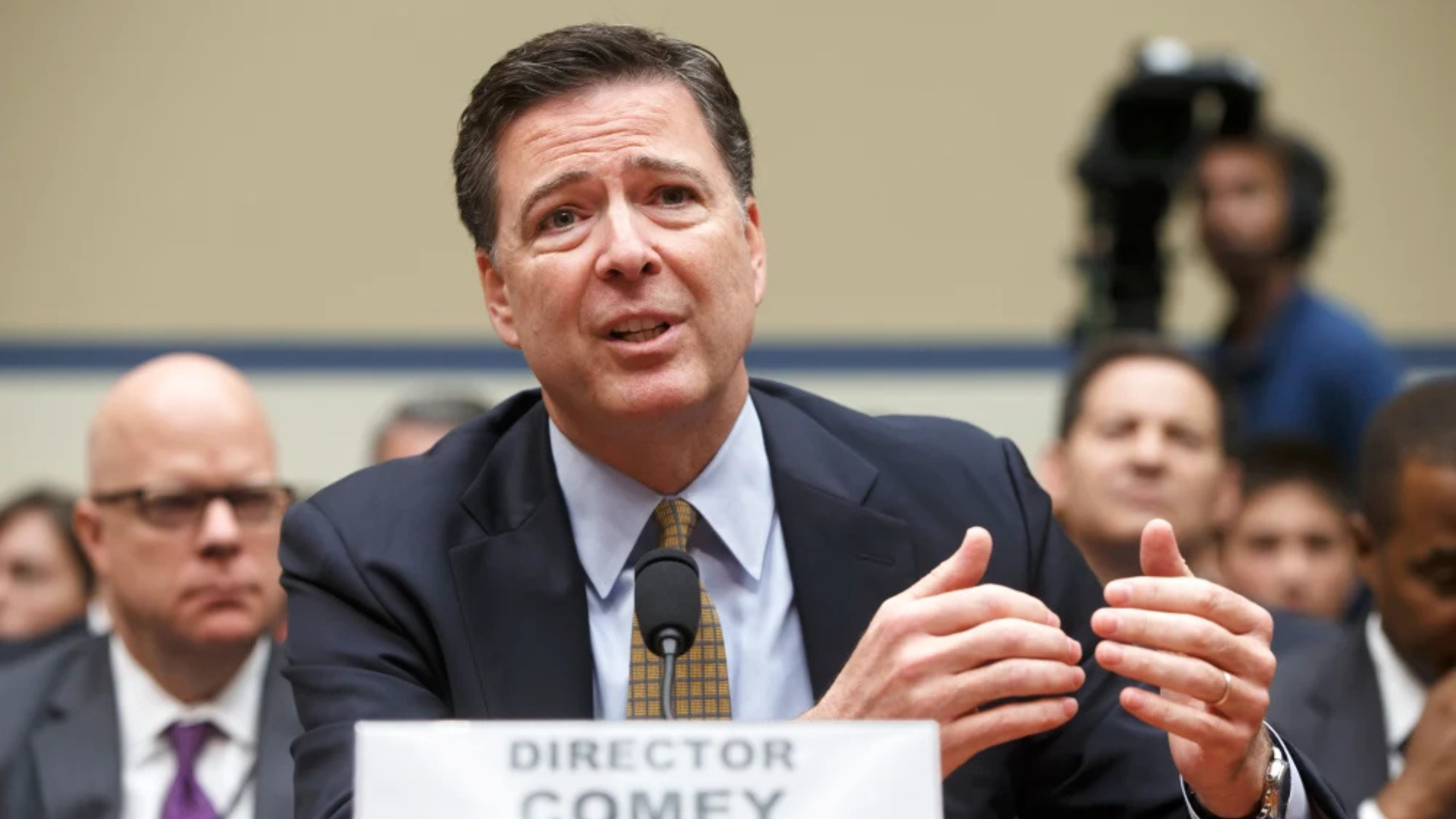Former FBI Director James Comey is under investigation by the U.S. Secret Service following an Instagram post that some interpret as a veiled threat against former President Donald Trump. The post featured seashells arranged to form the numbers “86 47,” which critics argue signifies “eliminate 47,” referencing Trump as the 47th president. Comey captioned the image as a “cool shell formation,” but the post has since been deleted amid backlash. He stated he was unaware of the connotation and opposes violence. The incident has intensified political tensions and prompted a federal investigation.
Understanding the ’86 47′ Controversy
The “86 47” controversy centers on a cryptic Instagram post by former FBI Director James Comey that quickly ignited a political firestorm. In the post, Comey shared an image of seashells arranged to form the numbers “86 47,” a phrase that many interpret as a coded call to “eliminate” Donald Trump, the 47th President of the United States. The number “86” is widely recognized in American slang, especially in law enforcement and hospitality sectors, as a term meaning to reject, get rid of, or “kill” something or someone. When paired with “47,” referencing Trump’s presidential number, it sparked alarm across political and social media platforms.
Understanding the slang behind “86” is essential to grasp why this post caused such a backlash. In hospitality, to “86” something means to remove it from the menu or refuse service, but the term has also been adopted colloquially to mean “get rid of” or even “kill.” This dual meaning raises significant concerns, especially given Comey’s high-profile status and history with Trump. Many critics, including political figures and commentators, saw the post as a veiled threat rather than an innocent shell formation. This interpretation led the U.S. Secret Service to launch an investigation, aiming to determine whether the post constitutes a credible threat.
The context of James Comey’s history with Donald Trump adds another layer to the controversy. Comey was fired by Trump in 2017, a decision that sparked intense political debates and led to the appointment of Special Counsel Robert Mueller. Comey has been a vocal critic of Trump’s presidency and policies, further fueling speculation that the post was intentionally provocative. However, Comey later stated that he was unaware of the meaning behind “86 47” and condemned any form of violence. He deleted the post shortly after the backlash began, but the damage in public perception had already been done.
The controversy also highlights the power and risks of social media communication, especially by influential public figures. A seemingly innocent post can be interpreted in vastly different ways, affecting public opinion and potentially triggering legal scrutiny. Social media platforms like Instagram and Twitter have increasingly become arenas where political tensions play out, often with significant consequences. The Comey incident demonstrates how symbolism and coded messages on these platforms can prompt national conversations about security, free speech, and political expression.
Finally, the broader implications of the “86 47” controversy extend beyond the individuals involved. It raises questions about political discourse in America today, the line between free speech and threats, and how law enforcement agencies monitor potential dangers emanating from social media. It also underscores the importance of clarity and responsibility when public figures communicate online. As this investigation proceeds, it will likely set precedents for how similar cases are handled, impacting how political messaging is interpreted and regulated in the future.
Federal Investigation and Political Repercussions
Following the controversial Instagram post by former FBI Director James Comey, the U.S. Secret Service launched an official investigation to determine whether the post constituted a credible threat against former President Donald Trump. The agency’s involvement underscores the gravity with which such posts are treated, especially when they involve former high-ranking officials and potential threats toward a former commander-in-chief. The investigation aims to verify if Comey’s post crossed legal boundaries or incited violence, reflecting the federal government’s zero-tolerance stance on threats to political figures.
Legally, threatening a former president, even indirectly, can lead to severe consequences under federal statutes. The Secret Service, responsible for protecting current and former presidents, has broad authority to investigate any suspected threats. While Comey publicly stated that he did not intend any harm and claimed ignorance of the post’s implications, the investigation highlights how social media content is scrutinized intensely in today’s politically charged climate. Experts suggest that this probe could set a precedent for how ambiguous but potentially threatening messages from public figures are handled in the digital era.
Politically, the ‘86 47’ post has intensified divisions across the American political spectrum. Supporters of former President Trump view the post as a deliberate attack, while Comey’s defenders argue it was an innocent mistake or an abstract artistic expression. This episode further exacerbates the polarized nature of U.S. politics, where every statement or gesture by public figures is dissected and weaponized by opposing sides. Politicians and media outlets alike have leveraged this controversy to rally their bases, influencing public opinion and media narratives ahead of upcoming elections.
The fallout from the incident also impacts Comey’s public image and legacy. Once seen primarily as a staunch law enforcement figure who played a pivotal role in major national investigations, Comey now faces renewed scrutiny and criticism. The controversy raises questions about the responsibilities of former government officials in using social media platforms and the potential repercussions of careless or provocative posts. It also spotlights the challenges authorities face in balancing free speech rights with the need to protect public safety and political stability.
Finally, this situation reflects broader concerns about the influence of social media on politics and national security. Platforms like Instagram, Twitter, and Facebook have become battlegrounds for political messaging, misinformation, and sometimes threats. The ‘86 47’ controversy serves as a case study in how digital expressions can have real-world consequences, prompting calls for clearer policies and stronger monitoring by both social media companies and government agencies. As the investigation continues, its outcome could shape future approaches to online speech, political discourse, and security protocols for public figures.
Public Reaction and Media Coverage
The public reaction to James Comey’s Instagram post has been polarized, reflecting the deep political divisions in the country. Supporters of former President Trump have condemned the post, viewing it as a direct threat and calling for legal action against Comey. Conversely, some individuals and media outlets argue that the interpretation of the post as a threat is an overreach, suggesting that the backlash is politically motivated. Major news organizations have provided extensive coverage of the incident, analyzing the potential legal ramifications and the broader societal implications. Social media platforms have been abuzz with discussions, memes, and debates surrounding the meaning of “86 47” and its appropriateness. The incident has also sparked conversations about the responsibilities of public figures in their online communications. Legal experts have weighed in, offering differing opinions on whether the post constitutes a prosecutable offense. The ongoing discourse highlights the challenges in balancing freedom of expression with concerns about incitement and public safety. As the investigation continues, the story remains a focal point in national conversations about political rhetoric and accountability.
Conclusion
The controversy surrounding James Comey’s Instagram post serves as a poignant example of how digital expressions can have significant real-world consequences. As the investigation by the U.S. Secret Service progresses, the incident continues to provoke discussions about the limits of political expression, the interpretation of symbolic language, and the responsibilities of public figures in the digital age. Regardless of the investigation’s outcome, the situation underscores the importance of mindful communication, especially for individuals in positions of influence.
The public and media’s engagement with the story reflects broader societal concerns about political polarization and the impact of social media on public discourse. As the nation watches closely, the resolution of this case may influence future standards for online conduct and the interpretation of potentially provocative content. The incident also highlights the need for clear guidelines and education on the implications of digital communication. In an era where a single post can spark national controversy, the importance of thoughtful and responsible online behavior cannot be overstated. The unfolding events will likely continue to shape conversations around free speech, political accountability, and the evolving landscape of digital expression. As developments occur, staying informed and critically engaged remains essential for all citizens.
Subscribe to trusted news sites like USnewsSphere.com for continuous updates.
[USnewsSphere.com / ax.]





